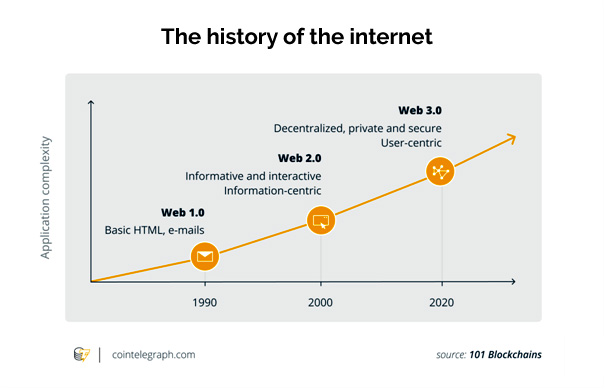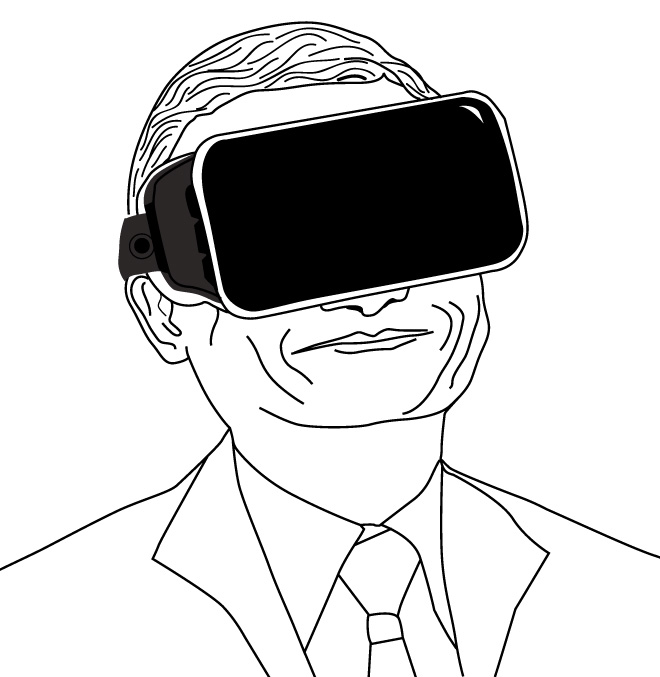The history of the internet has shown us just how powerful innovation can be. The development of mobile, social, and cloud infrastructure has transformed the internet from the dark and anonymous place it was pre-2004 into a technology that benefits over 3 billion people globally, and the evolution is just getting started. To understand just how important the future of the internet is, we must first look at the past.

Web 1.0
Web 1.0, the first iteration of the internet, was a strange place. It was characterized by a few creators, was read-only and had no room for user interaction. Websites only served static content and had minimal functionality.
Web 2.0
The launch of Facebook alongside other social networks and interactive platforms marked the dawn of Web 2.0. In this iteration, websites offered dynamic content that allowed deeper user engagement and enabled more people to become creators. This was the age of e-commerce, cloud, and social media. However, with these advances came a new set of problems. Centralized control and poor platform security led to imbalanced creator economies and disgruntled communities.
Fun fact: A large part of why Internet Explorer failed was because it was a Web 1.0 application trying to compete in a Web 2.0 world, while Chrome was built for Web 2.0.
Web 3.0
Web 3.0 is the next significant paradigm shift in the evolution of the internet and represents a fundamental disruption of the standard centralized model of web 2.0 and its “platform-takes-all” economics. Open, trustless, and permissionless networks are the future of Web 3.0. Innovations like the blockchain, DeFi, and NFTs are changing the way we communicate and share value on the internet, paving the way for a truly open economy where you can connect, engage and trade with anyone without unnecessary centralized control.

How Web 3.0 is powering the “open economy.”
Steve Jobs announced the iPhone in 2007 to a lot of applause and attention, but there was another technology that I believe was even more important than the phone itself – The App Store. The presence of a trusted platform that ensured safe distribution allowed more developers to create mobile apps and led to a $218 billion market by 2020.
However, in true Web 2.0 fashion, app stores have slowly evolved into walled gardens where centralized entities exert undue control while charging a significant percentage on the revenue that should accrue to app developers. This problem is not unique to app stores, it is evident in e-commerce and even traditional finance (Ever wondered why banking fees are so high and you have almost no choice but to pay them?).
Web 3.0 is set to change the landscape by decentralizing control and power from a single entity and sharing it with users and creators, who should be the real stakeholders. Why should a small business have to pay a huge chunk of their revenue to Amazon while still competing with the platform itself to sell to customers? Or why should Facebook dictate how your personal data is collected, used, and sold? With Web 3.0 technologies, the economy becomes truly “open“, and the power is back in your hands.
One of the easily recognizable applications of decentralization is blockchain and cryptocurrency. With a mobile phone and internet access, anyone, even in the most remote areas, can transfer and receive funds in minutes without a central entity processing the transaction. It’s completely open, anonymous, permissionless, and trustless.
NFTs are another Web 3.0 technology built on the blockchain that allows artists to earn directly from their art. Traditionally, when an artist sells a piece of art, they lose all rights to that piece and cannot earn directly from that piece ever again. With NFTs, however, an artist can earn a percentage of the piece’s price every time it’s sold. NFTs enable this with blockchain-powered smart contracts that provide a transparent, fool-proof mechanism for profit-sharing and collective decision-making, which will eventually address the inequity of art patronage, shifting the power dynamic within the industry.
Creating an ‘open’ future
So, how does a Web 3.0-powered future look? And what industries will it affect?
I predict that it will affect every industry, but I’m most excited about what the change means for global commerce and supply chains. For decades, the traditional global supply chain, particularly in the FMCG industry, has depended on an inefficient mishmash of manual paperwork, cash transactions, and disconnected local merchants. E-commerce is only marginally better, as centralized platforms like Amazon impose unnecessary restrictions that kill small businesses. With Web 3.0, however, we can finally create a true “sell anywhere” economy, where global brands can reach any merchant in any market and sell directly to them.
This is why we’re building RedCloud, the world’s first open commerce platform that connects brands, distributors, and retailers in the world’s fastest-growing economies together. Unlike the traditional distribution chain, RedCloud provides a completely open platform where brands and distributors can access valuable POS data across the supply chain, gaining valuable visibility that can be leveraged to eliminate any supply chain inefficiencies. Merchants can connect with global brands, offer their customers better products at more competitive prices, and build a digital trading profile that can be collateralized to provide access to credit facilities.
The time to build an open future that connects us is now, and Web 3.0 is key to that future.
Expect success!

